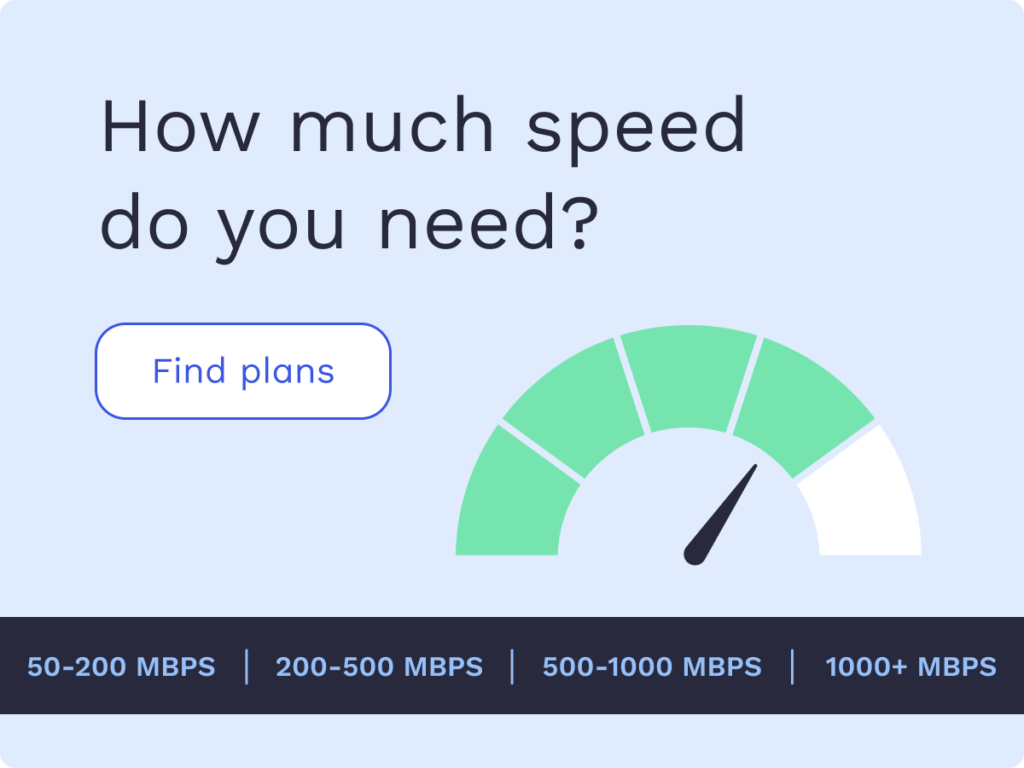What’s the Best Internet for Students?

Reliable, affordable internet is a must-have for students of all ages. Not having to worry about whether they can get online to attend class, perform research, or access key information means students can focus on what’s most important – learning. However, searching for services might feel a bit overwhelming for even the savviest of students.
While providers such as AT&T, Cox, Mediacom, and T-Mobile offer low-cost plans for families of K-12 students with limited income, plans from Xfinity, Spectrum and Frontier are more geared toward college students. But if you’re a student, your focus is more likely on your schoolwork, not digging through the details of internet service providers (ISPs) to figure out which one is best for you.
So we’ve done the heavy lifting and gathered all of the details you’ll need. In this comprehensive guide, we’ll cover package options, pricing, and frequently asked questions so you can select the best internet for you or your student.
The big players
There are generally two types of internet plans geared toward students. The first type focuses on families with students in grades K-12 who meet certain income requirements. The second type focuses on students attending college and living off campus (with limited options for some living on campus, too.)
K-12 student internet options
AT&T, Cox, Mediacom, and T-Mobile are four of the main players who offer discounted internet options for families with students in grades K-12.
AT&T
AT&T offers 25Mbps for $5 to $10/month with no contracts, data overage charges, or installation fees as well as a free modem for families who participate in Head Start, the National School Lunch Program (NSLP), or the Supplemental Nutrition Assistance Program (SNAP).
Mediacom
For households with at least one K-12 student who participates in NSLP, the Mediacom student plan offers no deposit, no contract, free equipment, and free installation for 25Mbps of speed at $10/month.
Cox
Families looking for a little bit more speed can consider a Cox student plan, which offers 50Mbps for $10/month. To qualify for the Cox plan, the family needs to have at least one student in grades K-12 and receive government assistance such as public housing, NSLP, SNAP, or Temporary Assistance to Needy Families (TANF).
T-Mobile
T-Mobile offers a student-friendly internet plan with 100GB a year at no cost. It also includes a free mobile hotspot for a minimum of five years, or a $500 credit to use toward a larger data plan.
The T-Mobile student plan is typically applied for by a school administrator and made available to children enrolled in NSLP. However, parents can apply on behalf of the school if necessary.
College student internet options
If you’re a college student in need of reliable and affordable internet options, Spectrum, Xfinity and Frontier may have what you’re looking for.
Spectrum
While Spectrum internet deals for students are primarily offered in residential areas, they are also available in some on-campus housing. Spectrum student plans start at $49.99/month for the first 12 months and offer 3 different speed options. You also have the option to bundle a Spectrum mobile plan which gives you access to the Spectrum network of Wi-Fi hotspots.
Xfinity
For a more affordable option, college students who qualify for public assistance programs might consider the Xfinity Internet Essentials program which offers a free wireless gateway and speeds up to 50Mbps for $9.95/month. As an added perk, students who qualify for this program also have the option to purchase a computer for $149.99.*
For college students living off campus who do not qualify for public assistance, Xfinity also offers student plans starting at $55/month for the first 12-months and includes a Visa Gift Card of up to $100 to help cover costs. These Xfinity internet plans come with a free-self install kit, too.
Frontier
Though not as widely available, Frontier offers a variety of student internet plans for undergrads. Frontier student plans come with unlimited data, no contracts, a free Wi-Fi router, and free security software for up to 10 devices starting at $39.99/month. Plan prices vary by region, so be sure to check with the provider for plan costs in your specific area.
Key considerations
Affordability
Before choosing an internet plan, it’s key to understand how much you can afford to pay on a monthly basis as well as potential price increases. Plans through AT&T, Mediacom, Cox, and T-Mobile for qualified K-12 students offer free equipment, no data overcharges, and no contracts. AT&T is the least expensive plan starting at $5/month for 25Mbps. But homes that need more speed can count on Cox for up to 50Mbps starting at $10/month.
Internet plans for undergrad students can be a bit more complicated. Xfinity offers plans for students on government assistance for as low as $9.95/month for speeds up to 50Mbps, but students who don’t qualify for government assistance might want to choose Spectrum since student plans start at $49.99/month for the first year. Be aware that some plans for college students increase after the first year and since you will likely be a student for longer than 12 months, it’s important to be aware of potential price increases down the road.
Speed
Another important aspect to consider is how much speed you’ll need. While internet packages with faster speeds may seem more enticing, you may not need as much speed as you think. For instance, general surfing of the web only requires speeds of 1Mbps, watching lectures online only requires speeds of 2.5Mbps and uploading or downloading high definition (HD) video requires speeds of about 25Mbps. Of course, if you’re sharing internet with multiple people or want to participate in online gaming, faster speeds might be a necessity.
Availability
Last but not least, once you’ve determined your budget as well as how much speed you need — you’ll need to determine which providers are available in your area.
K-12 students are most likely to have AT&T, Mediacom and T-Mobile options in their area since these three providers can be found in all 50 US states, while Cox might be a more limited option with coverage in only 19 states. College-age students will find Spectrum in 44 states, Xfinity in 40, and Frontier in 25.
What others are saying
AT&T
“Don’t hesitate if you can get an AT&T fiber plan, but research your options if only lower speeds are offered in your area.” – CNET
Cox
“Cox is in a three-way tie for No. 4 in our rating of the Best Internet Service of 2022, although it scored slightly lower this year than in our 2020 rating (3.8 compared to 3.9). It also ties for second place as Best Cable Internet Provider and for third as Best Fiber Internet Provider.” – US News & World Report
Mediacom
“As an internet service provider, Mediacom performs well, providing over 132% of promised speeds during peak hours according to the FCC’s Fixed Broadband report.” – US News & World Report
T-Mobile
“Setting up the modem, which comes with its SIM already installed, is extremely easy: You download an app on your phone, turn the modem on, and use the display on the top of the modem to find a location with good signal.” – PCMag
Spectrum
“In much of Spectrum’s 41-state service area, this cable internet provider is not just an obvious choice but the only one.” – US News & World Report
Xfinity
“If you find your plan to be insufficient for your needs, Xfinity will always be happy to bump you up to a plan that’s faster (and more expensive).” – CNET
Frontier
“Frontier ranks in an impressive seven out of the eight categories it’s eligible for in our Best Internet Service Provider ratings. It takes seventh in the Best Overall rating, second place in Best ISPs for Rural Areas, plus it’s No. 1 in Best DSL Internet Providers and Best ISPs for Gaming. It rounds out its tally with a sixth place in Best Fiber Internet Provides of 2022 and fourth place in Most Affordable ISPs.” – US World News & Review
Internet for students FAQs
Do any providers offer free internet for students?
Though a few providers such as AT&T, Comcast, Spectrum, Optimum, and Suddenlink offer free internet for qualifying families for 60 days, there are currently no programs being offered by major providers for long-term or permanent free internet for students.
Some school districts and college campuses across the country are partnering with providers to offer hotspots and internet-enabled tablets, so make sure you check with your district or college campus to see if this is an option for you.
Do I have to prove I am a student to qualify?
AT&T, Cox, Mediacom, and T-Mobile all offer programs for K-12 students which require families to show proof of qualification for certain government programs such as NSLP (qualifying programs vary by provider) as well as proof of a K-12 student living in the home. You’ll want to check with each provider for exact details of how to qualify.
College students will need to show proof of enrollment to qualify for internet geared specifically towards students, as well as eligibility for income-based government programs in certain situations. Requirements vary by provider so you’ll want to check with each provider for qualification details.*
*Pricing varies by location and availability. Speeds may vary. All prices subject to change; for current pricing and availability visit our internet service page. Prices as of 3/6/22.
Disclosure | Updater articles are based on our own data and research, independent from partner relationships. We are not compensated by partners for information and opinions presented here. Our Editorial Terms of Service can be found here.














